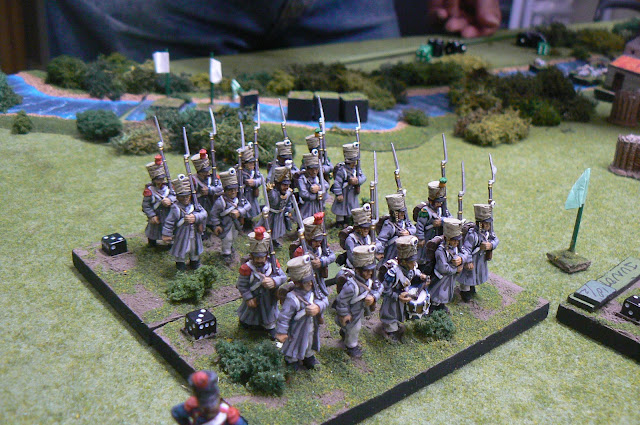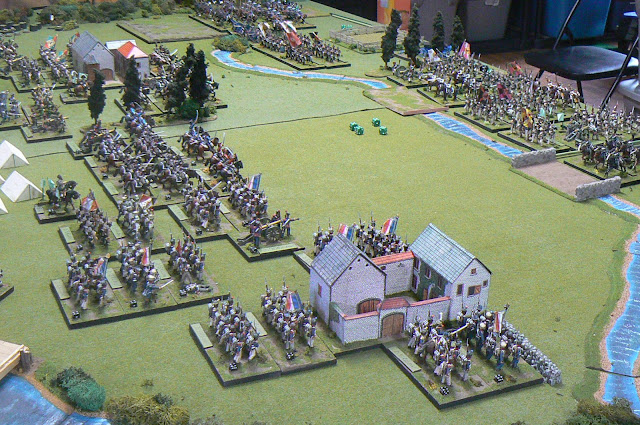Fine Day, the Cree Warrior Leader stared upon the Canadian soldiers with much confusion as they slowly walked in unison, a slow walk, their legs moving as a centipede. “Why do this?” he asked Small Bear. But his companion shook his head. “Starlings?”, Small Bear offered as the red-coated soldiers did walk as those birds flew, seemingly as one following unknown commands. But perhaps it is so we are confused as we are and will not attack? If that is their plan, it is working well thought Fine Day. Do we?, the warrior contemplated.
 |
| Stepford's contingent in full dress, practicing their formation drill on the open prairie. |
Across the meadow and for several hours now the rest of the convoy had moved north leaving a small contingent of the York and Simcoe Regiment to stand guard over the broken wagon, empty of its cargo, and guarding the artillery piece left here so it’s limber horses could provide the extra power to move the other overloaded wagons
Sgt. Simmons, commanding the gun crew, was resting looking up at the circling birds when his loader made the comment , “The gun just moved!” Getting up from his supine position, the sergeant witness the gun slowly but methodically gaining speed, muzzle first, toward a small gully. “Get up you buggers!”, he shouted to no one in particular.
 |
| Simmons, Dobkins and crew working to upright the cannon and get it into action. |
Two companies of the York and Simcoe Battalion were equally lounging in the midday sun, lifted their heads to see the artillery crew run after their cannon. Interestingly none got up to help as they remembered the afore mentioned artillery Sergeant suggest to the column’s commander that they could provide the horsepower to move the gun along. “We are not bleeping mules!” was the general consensus and the matter was dropped. Let the artilleryman now become their own mules to drag the damn gun from the bush. Heads returned to the reclining positions as their ears still could hear the sounds of frustrated artillerymen and the shouts of particularly ambitious colour sergeant who was parading his charges in full uniform up and down the grasslands.
This would continue for several minutes when a lone person walking with a limp, came into camp asking for the commander. “ I am one of Bolton‘s Scouts. I encountered a group of Cree moving this way. They shot my horse and I landed with a slight slight sprain. Got here as quick as God allowed but I must warn that you may be attacked”
Then the shots rang out from the clump of trees to the north-west…..
 |
| My simple terrain try of birch trees. the Cree are hidden somewhere amongst. [spoiler alert: I have no Cree. But in my defence, historically, the Canadian soldiers would not see any either!] |
So begins the solo scenario set up during the Canadian Northwest Rebellion using the ever unpredictable rules “The Men Who Would Be Kings”. The game begins with the cannon overturned in some scrub, an exposed Canadian militia unit in close order in the middle of a featureless prairie, two other companies unprepared for battle, and a number of natives firing away.
I had rolled for the Scout to give advance warning and my extremely low rolls for his movement speed suggests he was on foot only and hobbling at best.
 |
| Smith consults with the wounded Bolton Scout and his contingent faces the tree-line. |
For entertainment I rolled for the traits of each of the Canadian Leaders per the rules. The artillery has Simmons “a weakling” so no melee bonus [well, that makes sense for an artilleryman]. The marching unit under Stepford has a weak leadership of 7+ but with the trait as a “Musketry Buff” if activation orders for fire or volley he increases to 5+. [and this on the unit already in close formation, the volley fire bonus could be advantageous. Unfortunately it could not be used during the game]
The forward unit has a steady officer under Smith with the leader ship of 6+ and the rear unit under Gallant has [surprisingly I rolled box cars] hero status activation at 4+
The Cree shooting immediately gave Stepford’s marchers almost 50% casualties but they would not break and retired to the road as Smith’s Company poured steady but ineffective long range fire against the tree-line. To the south, Gallant’s company led by the “hero”, steadily moved to the flank of the Cree position and, yes, the artillery crew continued to upright the cannon and prolong it into a firing position
At this point the Cree fire ceased. The Canadians pondered whether the Cree had abandoned the attack or not [actually the Canadians were all out of affect of a long range fire, so I ceased to roll for firing!]
The artillery finally moved into position but… “Dobkins, you bloody idiot! Go back and get the ammunition!” …the artillery it fails it’s firing activation.
 |
| Dobkin at left. Does he finally have the correct ammunition? ( or more to the point, can I roll enough to activate the artillery firing?!) |
Meanwhile Gallant leads his company to flank the tree line when the tree-line explodes with gunfire, frightening in the militiamen and pinning them despite their fine leader.
 |
| The Canadian militiamen ready to charge into the woods. Smith's in the foreground, Gallant's depleted group in the distance. The smoke-balls are an indication of the Cree fire expenditure. Historically they were quite low on ammunition so I roll for the amount they have to fire, and lose d6 pip per activation attempt. Thus often they are forced to retire due to lack of ammo. |
“Dobkins! Bring the correct ammunition, damn you!” I read the rules with the artillery ignoring cover. Well, this should cause some Cree casualties. Wrong. I rolled no hits on 4+! But a turn later, finally the gun got into action regularly hitting the southern Cree unit and repeatedly pinning them. This allowed Gallant’s militiamen to approach closer without oncoming fire. Smith finally giving up on his long distance fire, double-timed it towards the tree line. He was rewarded by no further casualties. My Cree fire was rolling poor. The Canadian militiamen were surviving the weakening Cree fire; and for the most part the Cree were not willing to engage in hand to hand combat so with only a few rounds of ammunition left, they got on their horses and retired from the “Battle of Broken Wagon”
------------------------------------------
Game Notes:
-I needed a back-story to why one of my units is in march order but not the others; so the “centipede” narrative. This unit may only have convoy duties henceforth.
-no warning explanation in the story is for my very low movement rolls
-I only remove 1 figure regardless of hits, but account for the total hits for the important Pinning Tests. This serves to make the overall miniature removal a little more realistic but the rule’s pinning numbers remain intact.
-historically, the Canadian militiamen were enthusiastic but had very little training.
-the miniatures are with a metal artillery crew having new headdress modelled, and the infantry converted Perry plastic ACW Union types. Not perfect but with a wargamer’s squint…..
-I added the Perry Home Service helmets because I was given them, they did indeed wear them (!), and I did not thus need to model more glengarries!



















